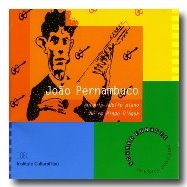 In Sao Paulo in 1929, Maestro Gaó (Odimar Amaral Gurgel) established a distinctive choro sound through his Orquestra Colbaz, who was organized to work for the Columbia recording company. The group included flute, bandolim, violin, violão, alto sax and accordion. Their bandolimist was José do Patrocinio Oliveira, known as Zé Carioca. The orchestra also included the violin of Ernestro Trepiccioni, and the timbre of the instrument provided an original sound which singularized the Cobaz among the choro groups. Orchestra Colbaz recorded frequently in the 1930's, including the first recording of Zequinha de Abreu's famous choro "Tico-Tico no Fubá" for Columbia Records in 1931.
In Sao Paulo in 1929, Maestro Gaó (Odimar Amaral Gurgel) established a distinctive choro sound through his Orquestra Colbaz, who was organized to work for the Columbia recording company. The group included flute, bandolim, violin, violão, alto sax and accordion. Their bandolimist was José do Patrocinio Oliveira, known as Zé Carioca. The orchestra also included the violin of Ernestro Trepiccioni, and the timbre of the instrument provided an original sound which singularized the Cobaz among the choro groups. Orchestra Colbaz recorded frequently in the 1930's, including the first recording of Zequinha de Abreu's famous choro "Tico-Tico no Fubá" for Columbia Records in 1931.
Alvaro Neder writes about Maestro Gaó in AMG:
"He began his musical studies at five with his father, the bandmaster Acilino, learning violin, trombone, flute, and piano. At nine he was already a professional pianist, playing in the local cinema, and at 11 he was the leader of the orchestra of the same cinema. In 1923, he moved to São Paulo, SP, enrolling in the Musical Conservatory and also becoming the pianist of Casa Di Franco, where he received the nickname Gaó. In 1925, he was hired by Rádio Educadora Paulista, playing in several formations from solo to orchestral, and in popular and erudite contexts. In 1929, he became the artistic director at Columbia, where he formed the Orquestra Colbaz, who, in 1931, did the first recording of Zequinha de Abreu's "Tico-tico No Fubá." In 1930, he was hired by Rádio Cruzeiro do Sul as a director and producer of shows that became famous, like Hora dos Calouros (presented later by Ary Barroso) and the Programa da Saudade. With lyrics by Vicente Lima, he published one valse for each month of the year through Vitale. In 1931, he wrote, arranged, produced, and recorded the music for Wallace Downey's film Coisas nossas. In the same year, he was appointed best pianist of São Paulo in a contest promoted by the newspaper A Gazeta de São Paulo. In 1932, he recorded his choro "Teimoso." Four years later, he moved to Rio de Janeiro, becoming the artistic director of Rádio Ipanema and also working at the prestigious Rádio Nacional as director of their jazz orchestra. In 1937, he performed for three months in Buenos Aires, Argentina, also playing in Uruguay. Returning to Brazil, he continued his work for radios Cruzeiro do Sul and Cosmos, also organizing the Orquestra Columbia, who animated balls and dances at élite clubs and recorded several albums. In 1938, he returned to Rio to work at Rádio Nacional, taking charge, in the next year, of the musical direction of the Cassino da Urca, where he worked until 1945. In that year, he moved to the U.S.A. where he stayed until 1951, working as a pianist and bandleader for the U.S. government, entertaining war veterans. He also recorded several 78 rpm albums for Coda. Returning to Brazil, he worked from 1951 to 1957 for Rádio Nacional (São Paulo). In 1957, he again went to the U.S.A., where he remained until his definitive return to Brazil in 1967. "
Audio samples of Orchestra Colbaz available at the IMS online search facility
Jo
 In Sao Paulo in 1929, Maestro Gaó (Odimar Amaral Gurgel) established a distinctive choro sound through his Orquestra Colbaz, who was organized to work for the Columbia recording company. The group included flute, bandolim, violin, violão, alto sax and accordion. Their bandolimist was José do Patrocinio Oliveira, known as Zé Carioca. The orchestra also included the violin of Ernestro Trepiccioni, and the timbre of the instrument provided an original sound which singularized the Cobaz among the choro groups. Orchestra Colbaz recorded frequently in the 1930's, including the first recording of Zequinha de Abreu's famous choro "Tico-Tico no Fubá" for Columbia Records in 1931.
In Sao Paulo in 1929, Maestro Gaó (Odimar Amaral Gurgel) established a distinctive choro sound through his Orquestra Colbaz, who was organized to work for the Columbia recording company. The group included flute, bandolim, violin, violão, alto sax and accordion. Their bandolimist was José do Patrocinio Oliveira, known as Zé Carioca. The orchestra also included the violin of Ernestro Trepiccioni, and the timbre of the instrument provided an original sound which singularized the Cobaz among the choro groups. Orchestra Colbaz recorded frequently in the 1930's, including the first recording of Zequinha de Abreu's famous choro "Tico-Tico no Fubá" for Columbia Records in 1931.












